FESTIVALPROGRAM BLOG
EXCERPTS IN GERMANSIMPLICITY - the art of complexity - ARS ELECTRONICA 2006 - Festival für Kunst, Technologie und Gesellschaft - Linz, Do 31. August – Di 5. September
5
Jul
Michihito Mizutani is a interaction designer who has been researching the unconscious communication that occurs between people.
Michihito Mizutani: Emotional Communication
5
Jul
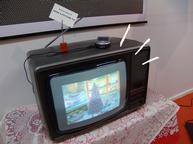 © Michihito Mizutani
© Michihito Mizutani
The Emotional Communication project provides a series of communication tools. They don’t mean to substitute the existing communication tools such as mobile phones. The Emotional Communication tools are subtle and quiet tools. They are useless when you need to give a clear message to others. We can use mobile phones in that case but the Emotional Communication tools will help you feel others who you want to be connected to. They mean to fill the gap of physical and mental distance between friends and family.
The communication tools are called Talking Glass, Sharing the Moment and Narrowcasting TV. Talking Glass is a cup, which enables users to enjoy interaction while they toast their glasses. In Sharing the Moment, a couple with a long distance relationship can share a moment of living together. Finally in Narrowcasting TV, elderly people can receive photos on their TV screens that are taken with a mobile phone by their children or grand children.
Emotional Communication: Michihito Mizutani
4
Jul
Li Xin (CN): BA in graphic design from Central Academy of Fine Arts, Beijing. BA in interactive media design from Designskolen Kolding, Denmark. Currently: MA degree student, Media Lab Helsinki. www.thoughtbird.com
Eirik Fatland (NO): BA in interactive media design from Designskolen Kolding, Denmark. Currently: MA degree student, Media Lab Helsinki. Role-playing artist. www.efatland.com
Li Xin & Eirik Fatland: Credits NeverEnding
4
Jul
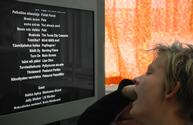 © Li Xin
© Li Xin
"Credits NeverEnding" is an interactive TV program, created for Finnish television channel Dina. Credits NeverEnding is intended for television's off hours, and was developed as part of a project to produce intentionally boring TV – "Boredom is a luxury anyone can afford".
The sight of movie credits on television is usually taken to signify the ending of one program, and the beginning of another. "Credits NeverEnding" subverts this convention by being credits for a movie that never existed, and holding the viewer in suspense for a program that never comes. The credits loop and change, but may scroll over the screen for hours at end.
The names and titles on the list come from the viewers themselves. A viewer with the right mix of attentiveness and time to kill will eventually discover the URL of the website where new credits may be entered. Viewers enjoy nearly total freedom to shape the neverending credits, including promoting themselves. Nothing is true until it is on television.
Credits NeverEnding: Li Xin & Eirik Fatland
3
Jul
Minna Nurminen (FI, born 1973) is a video editor currently working on interactive tv and cinema projects. Sankari in her master's thesis work at The University of Art and Design Helsinki.
Petri Kola (FI, born 1974) is an interactive media director, designer and researcher. Currently he is pursuing his PhD from The University of Art and Design Helsinki. For more information see www.petrikola.org
Minna Nurminen & Petri Kola: Sankari Show - The Ultimate Live Talk Karaoke
3
Jul
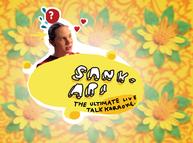 © Minna Nurminen, Petri Kola
© Minna Nurminen, Petri Kola
Sankari ('hero' in Finnish) is a new type of improvisational show. In the Sankari Show members of the audience make up and perform the lines for Elias, the main character, as he tries to navigate his way through everyday life's rough patches. Sankari is both media art and a TV-format. It received an honorable mention at the Transmediale05 digital art festival in Berlin and took the top prize at the 2003 MindTrek event. Currently, Sankari is being developed as a TV-show.
Participants in the Sankari Show compete against each other in the areas of verbal and improvisational ability. The hero of the show is Elias, but he doesn't have a voice – alone he is helpless. Contestants give him a voice and what they say determines his fate. Sankari offers people a fun way to perform in front of an audience. It's karaoke, a TV-drama and a video game.
Sankari was created at UIAH as the final thesis of Minna Nurminen and Petri Kola. From the very beginning, the idea was to create a media piece equally at home on television or as a performance at bars and festivals.
Sankari Show - The Ultimate Live Talk Karaoke: Minna Nurminen & Petri Kola
2
Jul
Campus | posted by Gerda Hinterreiter | at 14:30:00
Miikka Junnila, Andrii Khrupa, Anssi Mutanen, Noora Ojala & Karoliina Talvitie-Lamberg
Miikka Junnila (FI), MSc in computer science, and finishing his MA studies in New Media. Working background in semantic web research and university teaching, nowadays concentrating on innovative game, interaction and concept design.
Anssi Mutanen (FI), has great experience in computer games (since 1984), user centred design and GUI design.
Noora Ojala (FI), artist. Creativity in various fields of arts, and in different visual spaces - both public and private - and questions connected to it such as commercialism, domination and subjectivity. Creative resistance, studies in Fine Arts and New Media.
Karoliina Talvitie-Lamberg (FI), MA in literature and politics, MA in New Media(UIAH), PhD student. Grad. level film studies in UA, USA. Nowadays working as a concept designer, scriptwriter and teacher of new media scriptwriting. Working background copywriter, producer, PR manager.
Miikka Junnila, Andrii Khrupa, Anssi Mutanen, Noora Ojala & Karoliina Talvitie-Lamberg: Molly | Case
2
Jul
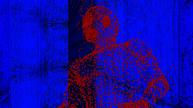 © Molly | Case
© Molly | Case © Molly | Case
© Molly | Case
Molly | Case is an interactive short film inspired by William Gibson's Neuromancer. Two people are longing for a connection with each other in a little hotel room of the future, but the different realities of the world as we know it, cyberspace and the world of dreams don't allow real contact. A mirror acts as a gate between the subjective realities of Case and Molly, and the user can change his/her point of view whenever he/she likes.
ICE, the invisible barrier software in the cyberspace makes sure data remains untouched. Similar psychological barriers keep all levels of reality cold and distant, from the electric, dynamic blues of the cyberspace to the lack of light in reality. This mood is the heart of the film. The mixed reality levels make the story complicated, and understanding the whole tragedy needs multiple viewings. This also emphasizes the need for interaction to open up the different perspectives.
Molly | Case: Miikka Junnila, Andrii Khrupa, Anssi Mutanen, Noora Ojala & Karoliina Talvitie-Lam
1
Jul
Helena Hyvärinen is a Finnish scriptwriter/Director/Producer who is graduating from the University of Art and Design Helsinki/Media Lab. She is mostly focusing on animation, documentary film and interactive media.
Reka Kiraly is a Hungarian born graphic designer living in Finland. She graduated from the University of Fine Arts Budapest in 2003, and finishing her studies at the University of Art and Design Helsinki 2006 spring. Her interest is in Inclusive Design and Illustration.
Cvijeta Miljak (HR) has been actively working in the field of visual communications since1998 (BA in graphic design). Currently attends MA studies in graphic design and new media at UIAH. Interested in experimenting with potential of various media regarding the interpretation of visual narrative structures.
Helena Hyvärinen, Reka Kiraly & Cvijeta Miljak: Päämaja/Headquarters
1
Jul
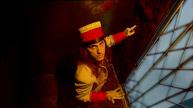 © Cvijeta Miljak
© Cvijeta Miljak
Päämaja/Headquarters is an interactive film on a DVD platform. The story is situated in a surreal world of elevators, and introduces a liftboy being challenged by an almost invisible antagonist – a flea – in a quest for power. An interactive point in the film reveals the possible outcomes of their struggle, and leads to three different conclusions. In general, the film explores aspects of the omnipresent theme of human relationship to power and plays with ideas of hierarchy and self perception.
Päämaja/Headquarters was inspired by ideas from Dostoevsky’s novel Crime and Punishment.
Päämaja/Headquarters: Helena Hyvärinen, Reka Kiraly & Cvijeta Miljak
30
Jun
Campus | posted by Gerda Hinterreiter | at 14:30:00
Janne Kaasalainen, Tanja Bastamow, Miikka Junnila, Miska Natunen & Jürgen Scheible
Tanja Bastamow (FI) is a production designer specialized in digital post
production for film and television, 3D animation and virtual set design.
She is currently launching her own company, Skyrocket Studios.
Miikka Junnila (FI), MSc in computer science, and finishing his MA studies
in New Media. Working background in semantic web research and
university teaching, nowadays concentrating on game, interaction and
concept design.
Janne Kaasalainen (FI) is currently working as a concept designer at Nokia
Research Center and finishing his MA & MSc studies. In the past he has
been working on game concepting and 3d animation on various projects.
Miska Natunen (FI) is an MA student at the Media Lab, University of
Art and Design, Helsinki. Experienced in web, game, sound and music
design, he's currently working as a concept and software designer for
Twinkle Oy, Helsinki.
Jürgen Scheible (Artist: Lenin’s Godson), Germany, a Researcher, Engineer and Media-Artist. He is a PhD candidate at Media Lab, Univ. of Art & Design, Helsinki and was a visiting scientist at MIT, USA. 2006 he became a Forum Nokia Champion, being a bridge builder between art & engineering.
Janne Kaasalainen, Tanja Bastamow, Miikka Junnila, Miska Natunen & Jürgen Scheible: Snowman in Hell
30
Jun
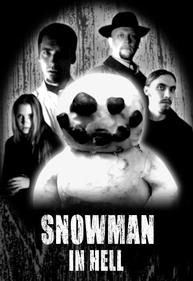 © Bastamow, Junnila, Natunen, Scheible
© Bastamow, Junnila, Natunen, Scheible
Hell is no place for a snowman - but some days are worse than others. You start a desperate journey through the perils of evil and treachery. Listening to the voice of a murdered man inside your head, you begin to realize that your fortune is bound to the souls burning in the eternal flames…
Snowman in Hell is an experimental computer game with hectic action and sophisticated puzzles. It’s also an epic horror story about a snowman with nothing to lose, inspired by Dante's Inferno and film noir.
There is a need for games that make things differently. Even a traditional platform game can feel fresh, if there is something new in the mix: schizophrenic dialogue during the levels, graphics made from garbage and clay, para-realistic simulation of physics, delicately grotesque soundscape… Quoting Pelit, the biggest game magazine in Finland: “Snowman in Hell guarantees an unforgettable experience".
Play it online at http://mlab.uiah.fi/snowman
Snowman in Hell: Janne Kaasalainen, Tanja Bastamow, Miikka Junnila, Miska Natunen, Jürgen Scheible
29
Jun
Koray Tahiroglu (TR)
He is a sound artist, performer and a researcher who grew up in Istanbul. He has been performing noise and electronic music collaborating with different sound artists and performers as well as with solo performances.
Joni Lyytikainen (FI)
He is a sound artist and freelance graphic designer living in Helsinki. His interest in sound has lead the way into electro-acoustic music and searching for new ways for musical creation in sonification of abstract data.
Koray Tahiroglu & Joni Lyytikäinen: SolarDuo Projekt
29
Jun
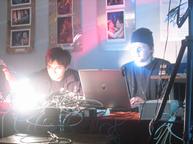 © Piia Hautamäki
© Piia Hautamäki
The project began during a workshop in 2003 at Media Lab Helsinki when Koray Tahiroglu & Joni Lyytikainen tried to connect a solar panel directly to a sound mixer. However, they discovered that more electric components were needed to achieve different sound structures from a solar panel. The artists created circuits that are based on the example by Ralf Schreiber, which inspired them to create their own solar panel instruments.
SolarDuo Project experiments with the possible sound structures that light waves can create. The project utilizes analog sounds together with the algorithms that generate changing set of sonic relations overtime. Analog sounds and computer generated sounds release an unexpected richness of the sound processing in real-time performances. In their performance they also sonify solar data, which is gathered from terrestrial and orbiting solar instruments.
SolarDuo Project performed at Piksel05 Festival Bergen/Norway, Ctrl_Alt_Del Sound Art Festival – the 9th Istanbul Biennial Istanbul/Turkey, Aureobel Launch Event, Art's Birthday 2005 and Art's Birthday 2004 in Helsinki/Finland.
SolarDuo Project: Koray Tahiroglu & Joni Lyytikäinen
28
Jun
Teemu Kivikangas is designer, media artist and film-maker working with
independent games and experimental movies. He’s member of VJ-group
Amfibio and Katastro.fi-collective. His films and works have been
exhibited in festivals in Finland and internationally.
Richard Widerberg (SE/FI) is a media-artist and musician working mostly with sound-related projects. His practice involves investigating the many dimensions of sound as well as making live performances based on his recordings.
Teemu Kivikangas & Richard Widerberg: Metamorphosis
28
Jun
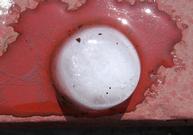 © Kivikangas & Widerberg
© Kivikangas & Widerberg
An audiovisual performance based on recordings of ice in both the Northern and the Southern hemisphere. The sounds used in the work are recordings from the ice of a lake in Northern Sweden. One can hear how the ice is constantly moving, affected by the wind, the temperature, the water beneath and the air pressure. Visual material depicts the same element, ice, in a very different context - South American megalopolises of Buenos Aires, Rio de Janeiro and Lima in the blazing heat of the summer – where it leads a short life before melting into water.
The visuals contrast and juxtapose the sounds from the isolated nature of the extreme North with images from the busy, overcrowded cities of the extreme South. This audiovisual material is then manipulated, re-cut and re-interpreted by the performers in real-time with two synchronized computers. The result is an experimental movie creating an image of transition, transformation and adaptation.
Metamorphosis: Teemu Kivikangas & Richard Widerberg
28
Jun
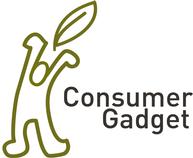 © Anna Salmi
© Anna Salmi
Consumer Gadget is a tool for consumers who would like to spend their money more ethically, supporting sustainable development and other good things. The main idea is to utilize the bar codes of consumer products for the cause of good: bar codes are unique identifiers that can be used to fetch ethical information about the product.
Consumer Gadget is a software for mobile phones, so it can be used at the time of purchasing. Users can scan bar codes with the latest camera phones and get the ethical information over GPRS connection, but the information is also available for users with older phone models using WAP or SMS technologies. Consumer Gadget can be used free of charge and it is based on open source technology.
Consumer Gadget: Wesa Aapro
It is being developed by non-profit organization Kulutuskapula ry based in Helsinki, Finland.
27
Jun
Teemu Kivikangas (FI) is designer, media artist and film-maker working with independent games and experimental movies. He's a member of VJ-group Amfibio and Katastro.fi-collective. Teemu's films and works have been exhibited in festivals in Finland and internationally.
Teemu Kivikangas, Sumea Studio, Digital Chocolate, Inc.: Johnny Crash & Johnny Crash Stuntman Does Texas
27
Jun
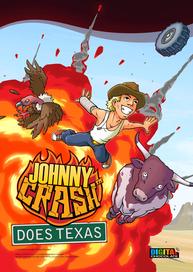 © Sumea Studio, Digital Chocolate, Inc.
© Sumea Studio, Digital Chocolate, Inc.
Two critically acclaimed mobile games about a teenager who has watched way too many episodes of certain reality television shows and is determined to become a celebrity himself by doing crazy stunts. Your goal as Johnny is to perform outrageous stunt flights as a human cannonball. Fly inside a thundercloud and be electrocuted by lightning or try crash landing into a cactus. Or maybe you need a haircut - trim your hair with helicopter blades! Never has performing pain-inflicting stunts been so freakishly entertaining.
Game play is simple and quick to learn - you need only one button to play - yet highly addictive and hard to master. After the flight you can review a replay of your flight and keep a scrapbook filled with snapshots of your "greatest hits". Titles are exhibited with focus on character development, illustrating the design process of game character from an initial idea into a finished product. Developed by Sumea Studio, Digital Chocolate Europe.
Johnny Crash & Johnny Crash Stuntman Does Texas: Teemu Kivikangas, Sumea Studio, Digital Chocolate, Inc.
26
Jun
Campus | posted by Gerda Hinterreiter | at 14:30:00
MobiLenin – Mobile Group Interaction with a Multi-track Musicvideo
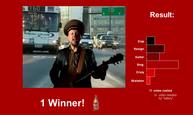 © Jürgen Scheible
© Jürgen Scheible
MobiLenin is an audience participatory art installation that allows people to interact simultaneously with a multi-track music video shown on a large public display using their personal mobile phones, effectively empowering the group with the joint authorship of the video.
It aims to provide enriched entertaining and social experiences by allowing people to interact with the musician “Lenin’s Godson” in the virtual domain, exceeding the limitations of the physical domain, e.g. by turning him into a skeleton.
By a collective vote using the mobile, the performance style of the artist can be changed in real time ranging from “not playing guitar”, “not singing” to performing as a skeleton. Voting occurs in ongoing voting intervals triggered by the system. As an incentive for interaction, MobiLenin provides a lottery. The winner receives a coupon for free pizza or beer in form of an image on the mobile phone.
MobiLenin provides a new form of interactive entertainment for pubs and other public places.
MobiLenin: Jürgen Scheible (Artist: Lenin’s Godson)
Blog Authors:
Maria Hieslmayr Cornelia Sulzbacher Wolfgang Bednarzek Gerda Hinterreiter Didi Offenhuber Beta Lounge Artists David Cuartielles Sonja Meller StWSt denCity.net
Search:
Categories:
Conferences Animation Festival Events, Concerts & Performances Campus Exhibitions e-lobby Prix Ars Electronica
Recent Posts:
Photographs of the 2006 Festival Media lab thanks! Ars Electronica Center FM4 Live from Ars Electronica in Linz
Archives:
Posts 60 - 40 Posts 40 - 20 Posts 20 - 0


